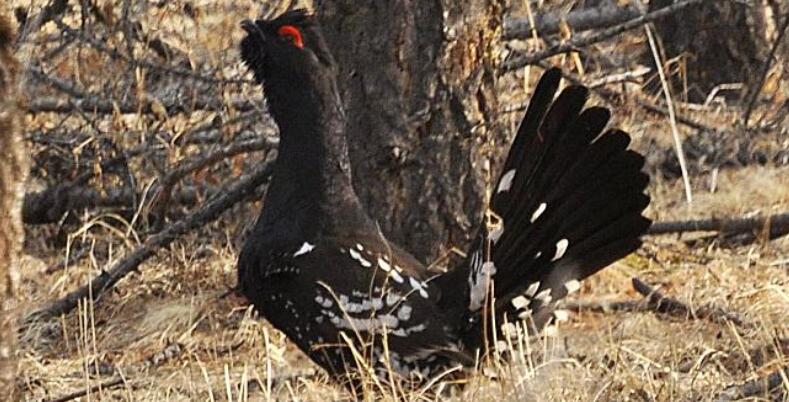Chosenia Arbutifolia and the Pinkish Water
Early April, the first glance at the Hanma National Nature Reserve is that of a picturesque tableau The clear blue sky stands out against the white snow and the purplish-red branches of Chosenia arbutifolia, a deciduous willow-like tree,that blooms ovoid, shiny petals in defiance against the bitter freezing cold.
The director of Hanma Nature Reserve, Hu Jingui, stated that due to its contrasting colors, the unique scenery of the Da Hinggan Mountains is often called “the pinkish water”. As the ice melts every spring, Chosenia arbutifolia sprouts new buds and their roots turn red, which seeps and dyes the surrounding waters. As the pinkish water melts the winter ice, birds of all kinds, including Tetrao parvirostris; black-billed caper-caillie can feel the approaching tendrils of spring, and the beginning of a new life cycle.
King of the Taiga Boreal Forest
Taiga is a biome, or a boreal forest, characterized by coniferous trees that stretch across North America and Eurasia. Hanma Nature Reserve’s taiga contains coniferous trees, a rare tree species in China as most are deciduous. The conifers are often reflected upon as guardians of the pure and peaceful northern sky.
Only the most daring animal would choose the top of the Taiga army as their playground. The blackbilled capercaillie, a first class national protected animal in China, often flies up to the top of the trees within the boreal forest to enjoy the sunshine and breeze, or takes cover in the lower branches from the freezing winter. They also perch on the trees to gain access to its juicy shoots, which plays an important role as an especially vital food source prior to the spring breeding season.
Courtship Display amongst the Taiga
Around Qingming Festival, also known as Tomb-sweeping Day, in April is the black-billed capercaillies breeding season. In order to attract a mate, a male bird will perform a courtship display, where he will use various postures, behaviors and actions, as well as the overt display of his plumages bright colors. Their iridescent feathers are a majestic diversity of aquamarine, dark green, crystal silver, with a bright red crest. Their courtship displays also includes the ruffling of feathers, integral dances, which include strutting, and vigorous movements that show the strength and power of the male bird such as lateral steps, bows, expanding their wings, and tail, and much more. Love songs and calls accompany these displays, and are used to attract females but also to deter rivals. Every male black-billed capercaillie acts like he is the king of the forest.
When the male black-billed capercaillie seeks a mate, he works extremely hard to be successful. Every morning, at 3:00am, the male birds arrive at “leks” to perform and sing mating calls for more than 4 hours. Leks are small areas such as low branches, mounts or rocks where the males will strut and sing. The male birds display as stated previously, and as they do, their tail feathers unfold, much like that of phoenix, while their love calls sound similar to “bang, bang,
bang”.
Observing the courtship of black-billed capercaillie can be fraught with challenges, but is highly rewarding, as every behavior of the birds relays their emotions, wants and needs to other birds, and after close observation these actions can be translated into a humans definitions of emotions.
The male black-billed capercaillie has about 45-50 days to seek his mate. But in the first 30 days, regardless of how often he sings or dances, the female birds will ignore the males and remain on the boundaries of the leks, attentively observing each male so that when it comes time for mating, they will choose the strongest and most powerful one. After 20 to 30 days the male birds will increase the intensity of their displays, and the females will enter into the leks, to choose their mate.
As the female birds decide upon their mates, it becomes a dangerous time for the males, as each fights to retain breeding rights. A less dominant male will leave quickly, even if he spent 4 hours a day dancing and singing to please the female for at least 30 days. Determined dominant males birds refuse to give up their breeding rights and transfer what was once tools of the dance of love, their wings, beaks and claws, into powerful weapons, pecking each other’s face and neck, expanding their strong wings to slap each other, and making ,the fighting calls of “bon! bon! ”. When their opponent is sufficiently deterred or exhausted, the male bird will mate with the female.
After the couple completes their mating, the female birds, new role is to nest, lay eggs, and after they hatch, raise chicks while the males seek solitude in the forest waiting for the next spring.























